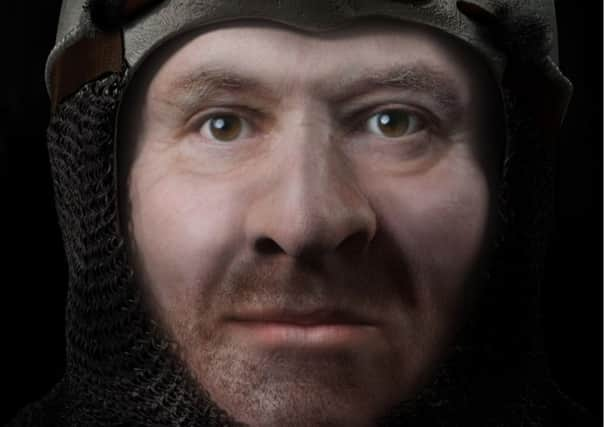Face of Robert the Bruce revealed in new documentary


A new BBC ALBA documentary, Ceann an Rìgh/The King’s Head, will reveal the face of Robert the Bruce as it follows the work of Britain’s leading expert on craniofacial reconstruction as she uses cutting edge digital technology to create a 3-D portrait of King Robert.
Professor Caroline Wilkinson of Liverpool John Moores University - who was responsible for re-creating the face of Richard III from his skull after his body was discovered buried underneath a car park in Leicester - has used a plaster-cast of Bruce’s skull to base the portrait on.
Advertisement
Hide AdAdvertisement
Hide AdThe muscles and tissues of the face are then added to the skull, using her knowledge of anatomy.
Commenting on the reconstruction, Professor Wilkinson said: “The finished head is really a very strong, robust looking male.
“He’s got a very strong neck, big shoulders, someone who’s used to physical activity.
“The other thing that’s come out of it is that he’s got quite a strong jawline.
Advertisement
Hide AdAdvertisement
Hide Ad“The muscle attachments on the skull suggest that he had very strong, well-built muscles which means that he was using them a lot and from that period of time we can assume that means he was quite a physical individual, either doing heavy manual labour, or involved in fighting.”
Bruce has been depicted for centuries in paintings, sculptures and films - without anybody actually knowing what he looked like.
The quest to reveal his face was launched by Dr Martin MacGregor, a historian at the University of Glasgow.
Martin has been obsessed with Bruce for decades and was inspired by Caroline Wilkinson’s work on other historical figures, including Robert Burns and Mary Queen of Scots.
Advertisement
Hide AdAdvertisement
Hide AdDr Martin MacGregor said: “Bruce was an interesting man and an exceptionally capable King.
“If we have new technology to tell us more about him, and get closer to him, it seems sensible to use it.
“I would like us to take every opportunity available to make that happen and to try to learn something new about this hero.”
The University of Glasgow’s Hunterian Museum and Art Gallery has a cast of Bruce’s skull in its collection.
Advertisement
Hide AdAdvertisement
Hide AdThe cast was taken in 1818 when workmen building a new church on the site of Dunfermline Abbey discovered the remains of a royal tomb.
The tomb is widely believed to be that of Robert the Bruce, who was buried in the Abbey in 1329 – although some historians suggest that it might be that of King David I who founded the abbey.
Caroline’s portrait may reveal if the head had signs of injuries that might have been sustained in battle.
It may also show of signs of leprosy, which Bruce was rumoured to have contracted.
Advertisement
Hide AdAdvertisement
Hide AdSuch evidence could settle the King Robert/King David controversy for ever.
Craniofacial reconstruction can’t reveal a person’s skin, eye or hair colour.
A number of Bruce’s Stewart descendants were red-headed but in the absence of DNA there is no evidence that he himself was.
His Stewart descendants ruled well into the period of artistic portraiture, and Martin MacGregor examines paintings in the Scottish National Portrait Gallery to attempt to discover the family traits that may run through King Robert’s bloodline.
Advertisement
Hide AdAdvertisement
Hide AdCeann an Rìgh / The King’s Head has been produced by Caledonia TV for BBC ALBA and will be broadcast on Thursday 15 December 2016 at 8.30 – 9.00pm.
Pictured is an image of the Robert The Bruce reconstruction. Image courtesy of Professor Caroline Wilkinson, Director of Face Lab, Liverpool John Moores University and the School of Humanities, University of Glasgow.